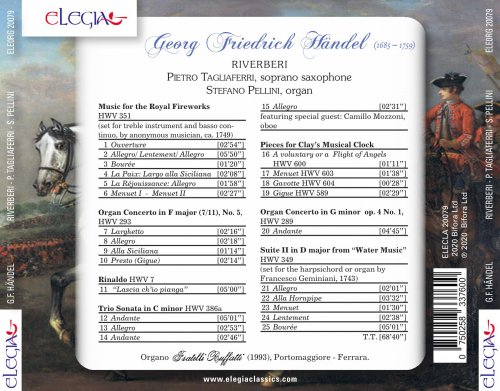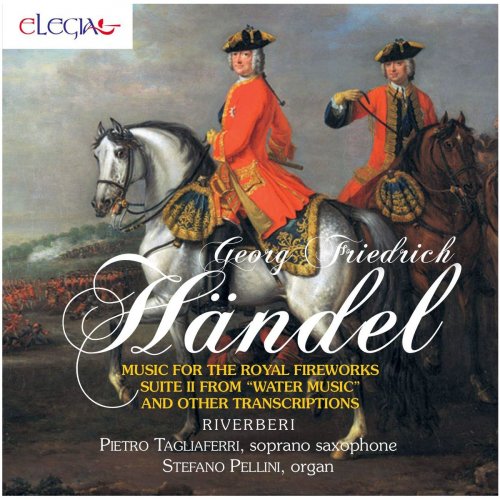
Pietro Tagliaferri - Georg Friedrich Händel: Music for the Royal Fireworks and Other Transcriptions (2020)
BAND/ARTIST: Pietro Tagliaferri
- Title: Georg Friedrich Händel: Music for the Royal Fireworks and Other Transcriptions
- Year Of Release: 2020
- Label: Elegia Classics
- Genre: Classical
- Quality: FLAC (tracks+booklet)
- Total Time: 68:30 min
- Total Size: 333 MB
- WebSite: Album Preview

Tracklist:
01. Music for the Royal Fireworks, HWV 351: Ouverture
02. Music for the Royal Fireworks, HWV 351: Allegro - Lentement - Allegro
03. Music for the Royal Fireworks, HWV 351: Bourrée
04. Music for the Royal Fireworks, HWV 351: La Paix. Largo alla Siciliana
05. Music for the Royal Fireworks, HWV 351: Le Réjouissance. Allegro
06. Music for the Royal Fireworks, HWV 351: Menuet I & II
07. Organ Concerto in F Major, Op. 4 No. 5, HWV 293: I. Larghetto
08. Organ Concerto in F Major, Op. 4 No. 5, HWV 293: II. Allegro
09. Organ Concerto in F Major, Op. 4 No. 5, HWV 293: III. Alla Siciliana
10. Organ Concerto in F Major, Op. 4 No. 5, HWV 293: IV. Presto. Gigue
11. Rinaldo, HWV 7: Lascia ch'io pianga
12. Trio Sonata in C Minor, HWV 386a: I. Andante
13. Trio Sonata in C Minor, HWV 386a: II. Allegro
14. Trio Sonata in C Minor, HWV 386a: III. Andante
15. Trio Sonata in C Minor, HWV 386a: IV. Allegro
16. Pieces for Clay's Musical Clock, HWV 600: No. 1, A Voluntary or a Flight of Angels
17. Pieces for Clay's Musical Clock, HWV 603: No. 2, Menuet
18. Pieces for Clay's Musical Clock, HWV 604: No. 3, Gavotte
19. Pieces for Clay's Musical Clock, HWV 589: No. 4, Gigue
20. Organ Concerto in G Minor, Op. 4 No. 1, HWV 289: I. Andante
21. Suite II, HWV 349 "Water Music": Allegro
22. Suite II, HWV 349 "Water Music": Alla Hornpipe
23. Suite II, HWV 349 "Water Music": Menuet
24. Suite II, HWV 349 "Water Music": Lentement
25. Suite II, HWV 349 "Water Music": Bourrée
After the recording dedicated to Johann Sebastian Bach (CD Elegia, Eleorg037, 2016), Riverberi continues his journey into the world of baroque repertoire featuring Georg Friedrich Handel’s music, exploring many musical genres addressed by the composer, from the Suite for orchestra to the opera aria, from the organ concert to the trio sonata. The intent is to offer a glimpse, as narrow as you want but still significant, that can intrigue the listener’s ear with a new sound experience, through the particular combination of two instruments so far apart - the organ and the soprano saxophone - to look incompatible. The arrangement for violin or flute (or other soprano instrument) and basso continuo of the famous Suite “Music for the Royal Fireworks” , which an anonymous composer wrote in the same year of its composition (1749) - yet another proof of the exceptional fame enjoyed by Händel when he was still alive – was a safe base of work: the various movements, from the solemn Ouverture to the graceful final minuets, exploit the rich sound combinations of the Ruffatti organ to display the different affections that this music offers. The Organ Concerto in F, transcription by Händel himself of the Sonata for flute HWV 369, is particularly suitable for combining the sound the two instruments: in slow movements, the sax keeps for itself the soprano part, in the second and fourth ones, the alternation of solo stops of the organ and the voice of the sax creates a particularly impressive tonal effect. The “Lascia ch’io pianga” Air, which Almirena addresses to the jailer Argante in the Rinaldo (but already used by Handel in “Il trionfo del tempo e del disinganno”), is so well known - but also so beautiful! - to appear almost obvious in this anthology; the performance alternates between two different perspectives: the one of the organ which, inspired by author’s transcriptions such as that by William Babell (1717), imbues the motif with long and sometimes complex embellishments, and the other of the sax, which, leaving the baroque paths for a moment, returns to its usual way of expression and gives jazz improvisations on the air. In this recording, for the first time a third instrument is added to propose a chamber music composition: it is the oboe, played by Camillo Mozzoni, professor at the Conservatory in Piacenza. For just this piece the use of a small positive organ, more suitable for basso continuo, was chosen as well as a less generous acoustics than the one of the vast hall of the Parish Church in Portomaggiore - more suitable for grandiloquent and sumptuous compositions - exploiting the “chamber” acoustics of the sixteenth-century sacristy of the church of San Sisto in Piacenza. Who among us knows Händel’s “Clock Music”? Around 1720, the clockmaker Charles Clay, from Yorkshire, presented himself to George I of England, offering his clock with sound pipes, and not without effort in 1723 he became the official supplier of His Majesty. Who could he turn to, if not to Händel, to have short motifs composed for his clocks to reproduce? Händel wrote both original and rearranged motifs for Clay. The four proposed here offer examples of different writing: from the fluttering of the angelic wings (to Flight of Angels), made admirably by the sounds of the 4 foot flutes of the Ruffatti organ, to the soft dance steps of the Minuet (all the 8 foot foundation stops of the organ), from the brilliant arabesques of the Gavotte (the small pipes of the Vigesimaseconda 1’ sound like chimes) to the grandiose notes of the Gigue (the Tutti of the organ), where you can listen to the power of the Ruffatti organ. The Andante from the Organ Concerto in G minor, a real “andante with variations”, soon reached such degrees of appreciation to be circulated autonomously and to have been the subject of countless transcriptions, including that of Marco Enrico Bossi: each variation is entrusted first to one then to the other instrument. None other than Francesco Geminiani in 1743 adapted for keyboard instrument another very famous Suite from Water Music (1717): according to the example of the anonymous transcriber of the Royal Fireworks – which opens this recording - he entrusted the saxophone to the most acute part, often alternating it with the solo organ stops (pay attention, for example, to the alternation of sax and the two Trumpets 8’ and the Chiarina 4’ in the Hornpipe, or the very particular tonal effect created by the Corno Inglese 16’ in the Lentement), with the intention of maintaining grateful fidelity to the language of that “Jupiter of Music” whose greatness continues to orbit, luminous, on our skies. Stefano Pellini
Year 2020 | Classical | FLAC / APE
As a ISRA.CLOUD's PREMIUM member you will have the following benefits:
- Unlimited high speed downloads
- Download directly without waiting time
- Unlimited parallel downloads
- Support for download accelerators
- No advertising
- Resume broken downloads


